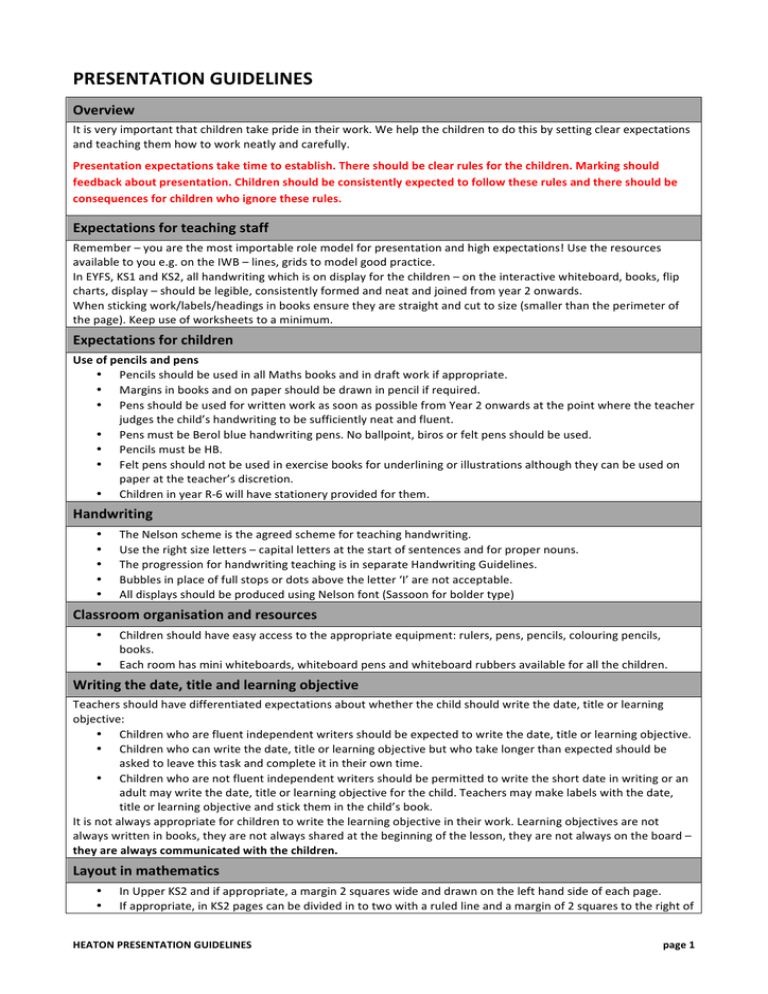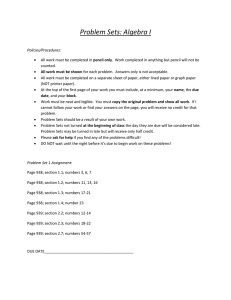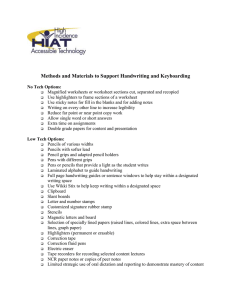PRESENTATION GUIDELINES
advertisement

PRESENTATION GUIDELINES Overview It is very important that children take pride in their work. We help the children to do this by setting clear expectations and teaching them how to work neatly and carefully. Presentation expectations take time to establish. There should be clear rules for the children. Marking should feedback about presentation. Children should be consistently expected to follow these rules and there should be consequences for children who ignore these rules. Expectations for teaching staff Remember – you are the most importable role model for presentation and high expectations! Use the resources available to you e.g. on the IWB – lines, grids to model good practice. In EYFS, KS1 and KS2, all handwriting which is on display for the children – on the interactive whiteboard, books, flip charts, display – should be legible, consistently formed and neat and joined from year 2 onwards. When sticking work/labels/headings in books ensure they are straight and cut to size (smaller than the perimeter of the page). Keep use of worksheets to a minimum. Expectations for children Use of pencils and pens • Pencils should be used in all Maths books and in draft work if appropriate. • Margins in books and on paper should be drawn in pencil if required. • Pens should be used for written work as soon as possible from Year 2 onwards at the point where the teacher judges the child’s handwriting to be sufficiently neat and fluent. • Pens must be Berol blue handwriting pens. No ballpoint, biros or felt pens should be used. • Pencils must be HB. • Felt pens should not be used in exercise books for underlining or illustrations although they can be used on paper at the teacher’s discretion. • Children in year R-­‐6 will have stationery provided for them. Handwriting • • • • • The Nelson scheme is the agreed scheme for teaching handwriting. Use the right size letters – capital letters at the start of sentences and for proper nouns. The progression for handwriting teaching is in separate Handwriting Guidelines. Bubbles in place of full stops or dots above the letter ‘I’ are not acceptable. All displays should be produced using Nelson font (Sassoon for bolder type) Classroom organisation and resources • • Children should have easy access to the appropriate equipment: rulers, pens, pencils, colouring pencils, books. Each room has mini whiteboards, whiteboard pens and whiteboard rubbers available for all the children. Writing the date, title and learning objective Teachers should have differentiated expectations about whether the child should write the date, title or learning objective: • Children who are fluent independent writers should be expected to write the date, title or learning objective. • Children who can write the date, title or learning objective but who take longer than expected should be asked to leave this task and complete it in their own time. • Children who are not fluent independent writers should be permitted to write the short date in writing or an adult may write the date, title or learning objective for the child. Teachers may make labels with the date, title or learning objective and stick them in the child’s book. It is not always appropriate for children to write the learning objective in their work. Learning objectives are not always written in books, they are not always shared at the beginning of the lesson, they are not always on the board – they are always communicated with the children. Layout in mathematics • • In Upper KS2 and if appropriate, a margin 2 squares wide and drawn on the left hand side of each page. If appropriate, in KS2 pages can be divided in to two with a ruled line and a margin of 2 squares to the right of HEATON PRESENTATION GUIDELINES page 1 • • • • • it. The previous piece of work should be ruled off with the date written in figures on the line below. The date and the title should be underlined. All figures must be written neatly and clearly with one digit to each square. Each calculation must be clearly numbered with the number in the margin to distinguish it from working figures. Write the short date i.e. 17.12.13 Presentation guide EYFS • I will stick my title sticker at the top of my page in the middle. I will start new work on the next clean page. • I will use a writing pencil for my work. • I will ask a grown up to help me rub out any mistakes. • I will not draw on the front of my book. Key Stage 1 • I will write the date on the left hand side at the top of my work. • In Year 2, I will miss a line before I write my Learning Objective (LO) or title. • I will write the LO or tilte on the left hand side • In Year 2, I will underline the date and title using a ruler in pencil. • I will not leave blank pages in my books. At the beginning of year 1, I will start a new piece of work on a clean page. By Summer Term of year 1 I will start a new piece of work by drawing a line under the last piece of work, and starting on a new line. By year 2, children should be drawing their own lines. • If I make a mistake I will put one neat line through it. • I will use pencil in my maths book. • I will write on the lines in my book. I will always write next to the margin. • I will write one digit in each square in my maths book. • I will write the short date i.e. 17.12.13 in maths and the long date i.e. Tuesday 17th December 2013 • I will use pencil in my books unless I have earned my handwriting license (in year 2) but I will not use felt pens or biros in my books. • I will not draw on the front of my book. • I will not draw pictures in my Literacy book unless I have been given plain paper to draw on. I will only use pencil for drawings. Lower Key Stage 2 • I will write the date on the left hand side at the top of my work. • I will miss a line before I write my title. • I will write the LO or title in the middle of the line. • I will write the short date i.e. 17.12.13 in maths and the long date i.e.17th December 2013 • I will underline the date and title using a ruler. • I will not leave blank pages in my books. If I start new work I will leave a line and draw a line using a ruler and pencil. • If I make a mistake I will put one neat line through it. • I will write on the lines in my book. I will always write next to the margin. • I will use pencil in my maths book. • When appropriate, I will divide my page in to two with a ruled line and a margin of 2 squares to the right of it. • I can use handwriting pen in books but only when my teacher tells me to but I will not use felt pens or biros in my books. • I will not draw on the front of my book. Upper Key Stage 2 • I will write the date on the left hand side at the top of my work. • I will write the title in the middle of the line on the next line down from the date. • I will underline the date and title using a ruler and pencil. • I will not leave blank pages in my books. • If I start new work I will leave a space and draw a line using a ruler and pencil. • I will write the short date i.e. 17.12.13 in maths and the long date i.e.17th December 2013 • If I make a mistake I will put one neat line through it. • I will write on the lines in my book. I will always write next to the margin. HEATON PRESENTATION GUIDELINES page 2 • • • I will use pencil in my maths book. I will use a handwriting pen for all of my work unless I am told otherwise. I will not use felt pens or biros in my books. I will not draw on the front of my book. HEATON PRESENTATION GUIDELINES page 3


